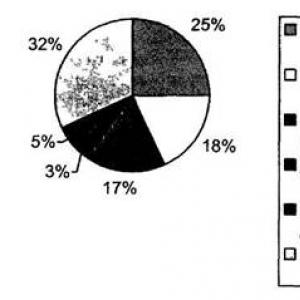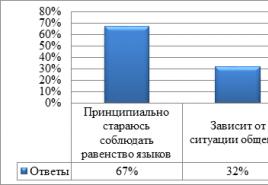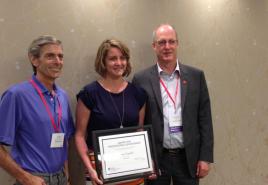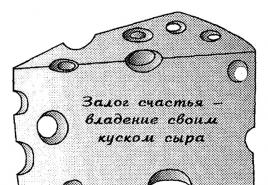The KonMari Method: Five Simple Tips for Cleaning Your Home. Mari Kondo's Japanese Cleaning: Decluttering, Folding and Other Secrets of the Maria Kondo Cleaning System
"There is no better way to understand yourself than to arrange a general cleaning in your house ..."I first read the famous book by Marie Kondo "Magic cleaning. The Japanese art of putting things in order at home and in life" in 2015, when I was pregnant with little Evochka. At the time, this book had absolutely no motivating effect on me. I just laughed a little at the principles that Konmari proposed for general cleaning of her house.
"... we take and throw away 2/3 of the property. With the rest of the third we carry on sincere conversations, we throw out arrogantly silent and arguing ones. We roll up the rest into rolls and put them in shoe boxes. Profit!" ()
Now, whatever one may say, putting things in order in the life of a working mother should begin with solving everyday household problems. For example, you need to determine and maintain the necessary and sufficient level of cleanliness of the space in the house. To date, I have already done a lot of work on my home. I still have some difficulties with maintaining the optimal level of order of things.
In my opinion, Mari Kondo has an amazing talent for cleaning up houses, but at the same time sowing chaos and confusion in the minds of her readers. The usefulness of practical (and sometimes very practical!) Advice on cleaning is intricately mixed with attempts to devalue and manipulate the feelings of its readers and readers.
"Marie Kondo, I think, is a great fellow. Her obsession with cleaning could have resulted in a full-fledged neurosis, but it turned out to be a vocation" ()
In my review of Mari Kondo's book Magical Cleaning. The Japanese Art of Tidying Up Home and Life, I will try to separate the benefits of this theory from its downright harm.
Benefits of Mari Kondo's Magical Cleaning
Tips that really work
- disassemble not a separate room, but a separate category of things;
- store all things by category;
- things should be stored where it would be more convenient not to take them out, but to return them to their place.
The third point of the above program turned out to be the most difficult for me. It turned out to be the easiest to organize storage in the bathroom and in the kitchen, with living rooms it is much more difficult. If a thing already has its place, then I put this thing in place automatically. If for some thing its place has not yet been determined, then this thing begins to wander aimlessly throughout the house. And it turns out that my entire current mess consists of things with an undefined storage location. And I have not yet figured out how to deal with it.
Harm (and nonsense) of KonMari theory
A philosophy of joy that you shouldn't bother with
First, let's talk about the dangers of KonMari theory. Here the situation is similar to (Marina Komissarova). Marie Kondo claims that none of her clients have ever complained about her work.
"Although my clients regretted throwing out specific items, they never complained afterwards."
In the academic environment, with its peer review system, there is an interesting observation
If your work has never been complained about, you have never been commented on, never criticized, then this means
- a) your work is not known to anyone, no one knows about it;
- b) your work is not interesting to anyone and no one pays attention to it;
- c) the work is done so unprofessionally that it will be senseless and thankless to criticize it, it is easier not to pay attention (see answer b);
- d) there is criticism for the work, it's just that the author stubbornly does not want to hear it.
"When I force clients to sort their belongings and get rid of unnecessary things, I don't stop halfway."
"When we really get to the bottom of the reasons why we cannot part with something ..."
"There aren't many really important events ..."
By the end of the book, KonMari has gone from being a cleaning and space organizer to a personal growth guru. And instead of teaching her readers and readers to fold rolls out of socks, she begins to teach us about life.
"We need to cherish not memories, but the person we have become as a result of past experience"
New posts in this LiveJournal appear at noon on Friday ... Well, or a little later!
Thank you for reading and commenting on my entries!
The Japanese method of magical cleaning will be that by tidying up a room, you can change your life for the better. Literally every person at least once in his life has experienced the reverse effect of cleaning the house, that is, the order in the room made him more perfect, smart and balanced.
Japanese cleaning method, about Maria Kondo
The Mari Kondo method (magic cleaning) is really very interesting and simple enough, thanks to which you can easily and quickly defeat the clutter of the house. The uniqueness of the method is that tidying up the room has a positive effect on all aspects of life, that is, on matters in the family and even at work. Maria Kondo devoted 80% of her life to this moment, she knows for sure that cleaning can positively transform the life of every person. Maria claims that here we will change the approach to cleaning, and only then will it have an amazing and very good effect on you. Since childhood, Maria Kondo has been looking for methods of perfect order in the house and has created her own method, today KonMari gives practical advice to everyone who wants it.
Cleaning in one fell swoop, striving for the ideal
KonMari argues that order should only be put in one fell swoop and throughout the room, otherwise another part of the room will quickly become cluttered again. If the cleaning takes place only partially, then the effect of the reverse negative impact on the person appears. Cleaning in the kitchen should take place immediately, that is, this process should not be prolonged, that is, one day to remove the refrigerator, the second set, and so on. Due to such a stupid and incorrect approach, there will be no order in the kitchen, so you should litter this room immediately and in one fell swoop. If you do the order in this way, you will immediately see the result, that is, order and cleanliness. This approach is required to be done in other rooms when cleaning.
Cleaning according to the KonMari method says that when cleaning itself, you should set a goal for yourself, as well as strive for perfection and ideal. This aspiration should be in literally everything, both in training and in simple cleaning, as this is of great importance. It will also be very important to clean the house quickly and thoroughly, otherwise you will not achieve a good result. The work should be carried out competently and as clearly as possible, and if the cleaning takes place at half strength, then you simply cannot put the house in order and do not get rid of all the trash at once. Cleaning will be able to distract from important and difficult matters and will help to find psychological balance, after which a person will have the strength to achieve life goals.
Cleaning by category, principles of work
The Japanese unique method of cleaning KonMari is organizing and sorting all things into various categories such as clothes, books, cosmetics, combs, and so on. It is required to first calculate the number of items in each category, while determining their usefulness and importance for oneself. Now it is required to solve two problems, that is, to throw out unnecessary items and the second task is to think over a storage place for the remaining things in the house. Here you should remember about the main general rules, that is, we do it once and for all, the cleaning lasts a little forever, as well as the rule to strive for the ideal in work.
The famous Marie Kondo advises making the day when you get rid of unnecessary trash and put everything in order as a holiday that can be a turning point in life.
You might also like:
 Is it worth combining a toilet with a bathroom - advantages and disadvantages
Is it worth combining a toilet with a bathroom - advantages and disadvantages
 We save space in the closet, the Japanese method
We save space in the closet, the Japanese method
 How to save space in a small apartment
How to save space in a small apartment
 How inexpensive to decorate a children's birthday?
How inexpensive to decorate a children's birthday?
 How to inexpensively decorate a room for your birthday?
How to inexpensively decorate a room for your birthday?
 How to cheaply decorate a kindergarten for the New Year
How to cheaply decorate a kindergarten for the New Year
Difficult steps towards minimalism
Angela Buttolf, style expert, author of articles and bestselling book The World's Most Famous Wardrobe: The Kate Moss Style, was as impressed as we, and many of you, with Marie Kondo's revolutionary approach to tidying up and shared her experience of living in throughout the year by the KonMari method in the column for telegraph.co.uk.
ItWorked has studied her experience and brings you the most interesting conclusions of a minimalistic experiment.
Start experiment
When guests come to Angela's country house, their first impression is always: “This is a minimalist paradise. Where are all the things? " That's because Angela is obsessed with decluttering and has gotten rid of more than half of her property over the past year.

Angela Buttolf
The sensational bestseller by Marie Kondo “Magic cleaning. The Japanese art of putting things in order at home and in life ”, which sold more than 3 million copies and made its author a part of the TOP-100 most influential people in the world according to Time magazine in 2015.
And if you've read it, you've probably also thought about how decluttering will attract good luck and radically change your way of life. Well, then, most likely, they just put it on the shelf.
But this is not about Angela. It took her a year of stress, discomfort, doubts, carrying heavy loads and irrepressible determination to implement the essence of the KonMari method into her life.
“From the very first pages of the book, I became an ardent adherent of the KonMari method. I sat at home with my child and hated my surroundings. Therefore, Marie's promise that tidying up the house would positively affect all other aspects of life - including work, brought me into a state of ecstasy. "
Angela liked the KonMari method with its geometrically folded things, vertically stored clothes, thanks to which it was possible to see all of her things at the same time, from the very beginning. She wanted there to be fewer things, and only those, as the author of the method insists, that bring joy. She started on January 1, 2015 and never looked back.
Implemented rules
One of Mari's rules is to declutter one category at a time. But the author is a tidying pro who never rolls his socks into a ball because "socks should have time to rest."
And Angela is a working mom with a chaotic work-life balance without a car and the wife of a graphic designer who doesn't throw anything away and considers it appropriate to display packages from different detergents on the bookshelf, because it "inspires" him.
But she managed to adopt the method, and this is how she did it.
1. Get rid of unnecessary clothing
She gave clothes of mass-produced brands and children's clothes for sale to a Facebook friend who was selling clothes on eBay, leaving herself 25% of the sale. ( approx. ed. - in Ukrainethere are also similar sites, for example,brand- fashion. com. ua, and for 10-15% of the sale there are people who will sell your things forolx and other sites, the rest can be donated to the Laska charity store).
The gradual decluttering freed up space and generated cash flows throughout the year.

Buying a branded item, then you have to shrink a lot, and you get pennies from selling it. Therefore, Angela decided for herself: "It's better to be a buyer of a designer second-hand than a seller."
2. Find a friend for support
But it should be noted right away that a life partner is not suitable for this. The number of things you intend to get rid of can shock him / her.
So Angela opted for her best friend, who has twin boys at the age of her daughter, and the basement is crammed with things from which her children grew up long ago. They exchanged text messages like: “Today I took 5 packages to the charity store. Congratulate me! ”, And rejoiced at the transformation of the cabinets, which were now dominated by vertical order.
“Start living according to the system“ I got one thing, got rid of one thing ”. This is the best way to stop piling up stuff. Do you really not like the thing that you have to get rid of by buying another one? For example, I now have 6 T-shirts, and this will remain so ”

Earlier, cleaning Angela took a lot of time and stress, now every thing has its own place, and there are so few of them that regular cleaning takes place as quickly as possible.
When things are scarce, you stop looking for something forever. It's amazing how many things you can live without, Angela concluded.
3. Leave only what you really use
Once a rat climbed into Angela's house. During the search for a rodent, she and her husband were forced to move furniture in the kitchen.
As a result, they decided that a toaster was not needed - it is perfectly replaced by a grill, and a kettle too - it is completely replaced by a coffee machine. They now have one pot and one pan. And they do just fine with this set. And if a year ago there were 25 boxes with things in the attic, now there are only ... the most needed New Year's toys.
Read also :
Angela considers it her personal achievement that they do not have a box for little things. All things are organized, needed in boxes. They don't have a box of unidentified cables, each gadget has its own charger, which is stored in the box. And yes, Angela is happy about that.
“Over time, it became more difficult to figure out what else to get rid of. It seemed to me that I live in an interior from a glossy magazine and I lazily ask myself from time to time whether I am tired of this wooden spoon or whether this object causes joy - this is the main idea of \u200b\u200bcleaning according to the KonMari method. "

The fewer things, the easier it is to recognize those that have not been used in several years or that have ceased to be liked.
4. Connect other family members
In the first six months of decluttering, the only thing that Angela's husband did was take things out of the heap “for disposal” with the question: “Don't we need this anymore?” or worse, put them back in place.
But in the end, he succumbed to the KonMari method, announcing in July that he was ready to revise his wardrobe of 500 pieces.
“For the daughter and for all other family members, the rule is“ one gift for a holiday ”. A categorical ban was imposed on soft toys. And next year we will generally switch to gifts-impressions "
They stopped going to toy stores. As Angela explains, the daughter is visiting, goes to the kindergarten, she has no shortage of a variety of toys.
“We made the only exception for books - we buy a lot and use the library. We must have at least some kind of whim "

5. Set a deadline
Marie Kondo recommends setting a deadline in the book. Angela set for herself on December 31st. What could be sold - sold, the rest went to charity stores. The latter is often preferable to the former. Considering how much money you get and how long it takes to sell.
It is done.
“You will definitely have bouts of regret about what you have done. At some point, I decided that I would no longer waste my time straightening my hair. And when I was going to a party with my friends, I was furious, not finding a single iron. I was really sorry. But, you know what? This year taught me that things are not that important in our life. And this is the most important lesson of all. "
The first step is to create in your head a picture of your ideal home. Colors, volumes, decorative elements, light ... Marie Kondo's technique is not to free up space at any cost, but to "organize it to create the living conditions that you like."
2. Tune in
While your head is full of everyday activities, you will not be able to deal with the chaos in the house. Don't panic looking at mountains of things. Choose a quiet place where you can appreciate the place of each object in your universe. Anything that will allow you to enter this state will do: quiet, unobtrusive music or the muttering of the TV. But silence is the best ally.
"Items hidden from view are usually not used for years."
3. Make a decision right away
When you feel ready, start sorting things. First of all, decide which items are not needed. For optimal results, stick to the following rule: Either throw away the excess immediately or put it back.
4. No "just in case"
The only question worth asking when looking at each thing is: "Does it make me happy?" If the answer is no, you know what to do. Quite often we are tormented by doubts: “Maybe I still need this? I will always have time to throw it away. " Hesitation means that you are attached to a thing. Think about when and why you bought it. Is it important to you today, as before?
5. Sort things by category, not by room
Chaos is when things have no place and they wander from one corner to another at will. Keep everything that belongs to the same category in one place. Look around the house for similar items (cleaning supplies, jewelry, cosmetics). Divide them into groups on the floor. This way you will be able to estimate the volume of things belonging to one category and understand how and where it is best to keep them.
6. Do not fill boxes more than 90%
The storage spaces that are packed to capacity are black holes. What is hidden from view is usually not used for years. We forget about the pots, socks, and notebooks that are barricaded in cupboards and dressers. “We tend to try to fill in the gaps,” says Marie Kondo. “But if the goal is order, it's better to have everything in sight. Limit yourself to one or two rows so that you can see the contents of each shelf. "
7. Fold clothes with origami
Clothes that are haphazardly folded take up more space and create a sense of disorder. The best way to avoid this is to always stack things in the same pattern. Use Japanese origami techniques. “Practice a few times and you will do it automatically every time, like a robot,” the expert says.
8. Create your "place of power"
A comfortable sofa, a table fenced off by a screen, a rocking chair - there should be a place in the house that will serve you as a refuge (or den). “Having personal space is very important for your peace of mind. It will warm you from the inside, like a warm cat in his bosom in the winter cold, ”says the coach. A small corner is enough.
9. Deal with the past
Things that are dear as a memory of the emotions associated with them are not only “centenarians” in our home, but also a major source of disorder. How can you throw that ticket to a concert where you had such a good time? And this camera that your grandfather used to shoot you as a child? Precious memories will not disappear even if you part with their physical embodiment. If necessary, spend some time with a valuable item. Take a picture of it, describe it. Accept that she no longer belongs to your life today. Parting with the past is important to make room for the present and the future - literally and figuratively.
10. Use things meaningfully
To maintain order on a daily basis, Mari Kondo advises following certain rituals: always put things back in place, thank them for using them, and take care of them. “When you finish tidying up the house, it will become clear to you what the meaning and purpose of each thing is,” explains the coach. - You will understand their true value and learn to deal with them consciously. This approach is a guarantee of not only physical purity, but also clarity of mind and inner harmony. "
About the expert
Marie Kondo - a consultant on the organization of home life, the author of the bestseller “Magic cleaning. The Japanese art of putting things in order at home and in life ”(Eksmo, 2016).







